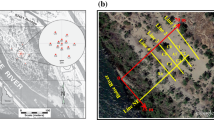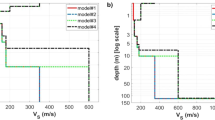Abstract
As theory dictates, for a series of horizontal layers, a pure, plane, horizontally polarized shear (SH) wave refracts and reflects only SH waves and does not undergo wave-type conversion as do incident P or Sv waves. This is one reason the shallow SH-wave refraction method is popular. SH-wave refraction method usually works well defining near-surface shear-wave velocities. Only first arrival information is used in the SH-wave refraction method. Most SH-wave data contain a strong component of Love-wave energy. Love waves are surface waves that are formed from the constructive interference of multiple reflections of SH waves in the shallow subsurface. Unlike Rayleigh waves, the dispersive nature of Love waves is independent of P-wave velocity. Love-wave phase velocities of a layered earth model are a function of frequency and three groups of earth properties: SH-wave velocity, density, and thickness of layers. In theory, a fewer parameters make the inversion of Love waves more stable and reduce the degree of nonuniqueness. Approximating SH-wave velocity using Love-wave inversion for near-surface applications may become more appealing than Rayleigh-wave inversion because it possesses the following three advantages. (1) Numerical modeling results suggest the independence of P-wave velocity makes Love-wave dispersion curves simpler than Rayleigh waves. A complication of “Mode kissing” is an undesired and frequently occurring phenomenon in Rayleigh-wave analysis that causes mode misidentification. This phenomenon is less common in dispersion images of Love-wave energy. (2) Real-world examples demonstrated that dispersion images of Love-wave energy have a higher signal-to-noise ratio and more focus than those generated from Rayleigh waves. This advantage is related to the long geophone spreads commonly used for SH-wave refraction surveys, images of Love-wave energy from longer offsets are much cleaner and sharper than for closer offsets, which makes picking phase velocities of Love waves easier and more accurate. (3) Real-world examples demonstrated that inversion of Love-wave dispersion curves is less dependent on initial models and more stable than Rayleigh waves. This is due to Love-wave’s independence of P-wave velocity, which results in fewer unknowns in the MALW method compared to inversion methods of Rayleigh waves. This characteristic not only makes Love-wave dispersion curves simpler but also reduces the degree of nonuniqueness leading to more stable inversion of Love-wave dispersion curves.










Similar content being viewed by others
References
Aki K, Richards PG (1980) Quantitative seismology. W.H. Freeman and Company, San Francisco
Beaty KS, Schmitt DR (2003) Repeatability of multimode Rayleigh-wave dispersion studies. Geophysics 68:782–790
Beaty KS, Schmitt DR, Sacchi M (2002) Simulated annealing inversion of multimode Rayleigh wave dispersion curves for geological structure. Geophys J Int 151:622–631
Bullen KE, Bolt BA (1985) An introduction to theory of seismology, 4th edn. Cambridge University Press, Cambridge
Calderón-Macías C, Luke B (2007) Improved parameterization to invert Rayleigh-wave data for shallow profiles containing stiff inclusions. Geophysics 72(1):U1–U10
Dorman J, Ewing M (1962) Numerical inversion of seismic surface wave dispersion data and Crust-Mantle structure in the New York-Pennsylvania area. J Geophys Res 67:5227–5241
Eslick R, Tsoflias G, Steeples DW (2008) Field investigation of Love waves in near-surface seismology. Geophysics 73(3):G1–G6
Forbriger T (2003) Inversion of shallow-seismic wavefields: I. Wavefield transformation. Geophys J Int 153:720–734
Golub GH, Reinsch C (1970) Singular value decomposition and least-squares solution. Num Math 14:403–420
Gu YJ (2010) Arrays and array methods in global seismology. Springer, Berlin
Harkrider DG (1964) Surface waves in multilayered elastic media I. Rayleigh and Love waves from buried sources in a multilayered elastic half-space. Bull Seismol Soc Am 54(2):627–679
Ivanov J, Miller RD, Xia J, Steeples DW, Park CB (2006a) Joint analysis of refractions with surface waves: an inverse solution to the refraction-traveltime problem. Geophysics 71(6):R131–R138
Ivanov J, Miller RD, Lacombe P, Johnson CD, Lane JW Jr (2006b) Delineating a shallow fault zone and dipping bedrock strata using multichannel analysis of surface waves with a land streamer. Geophysics 71(5):A39–A42
Lee WB, Solomon SC (1979) Simultaneous inversion of surface-wave phase velocity and attenuation: Rayleigh and Love waves over continental and oceanic paths. Bull Seismol Soc Am 69(1):65–96
Liang Q, Chen C, Zeng C, Luo Y, Xu Y (2008) Inversion stability analysis of multimode Rayleigh-wave dispersion curves using low-velocity-layer models. Near Surf Geophys 6(3):157–165
Lin C-P, Chang T-S (2004) Multi-station analysis of surface wave dispersion. Soil Dyn Earthq Eng 24(11):877–886
Lu L, Wang C, Zhang B (2007) Inversion of multimode Rayleigh waves in the presence of a low-velocity layer: numerical and laboratory study. Geophys J Int 168:1235–1246
Luo Y, Xia J, Liu J, Liu Q, Xu S (2007) Joint inversion of high-frequency surface waves with fundamental and higher modes. J Appl Geophys 62(4):375–384
Luo Y, Xia J, Miller RD, Xu Y, Liu J, Liu Q (2008) Rayleigh-wave dispersive energy imaging by high-resolution linear Radon transform. Pure Appl Geophys 165(5):903–922
Luo Y, Xia J, Miller RD, Xu Y, Liu J, Liu Q (2009a) Rayleigh-wave mode separation by high-resolution linear Radon transform. Geophys J Int 179(1):254–264
Luo Y, Xia J, Xu Y, Zeng C, Miller RD, Liu Q (2009b) Dipping Interface mapping using mode-separated Rayleigh waves. Pure Appl Geophys 166(3):353–374
Luo Y, Xia J, Xu Y, Zeng C, Liu J (2010) Finite-difference modeling and dispersion analysis of high-frequency Love waves for near-surface applications. Pure Appl Geophys 167(12):1525–1536
Luo Y, Xia J, Xu Y, Zeng C (2011) Analysis of group-velocity dispersion of high-frequency Rayleigh waves for near-surface applications. J Appl Geophys 74:157–165
Marquardt DW (1965) An algorithm for least squares estimation of nonlinear parameters. J Soc Ind Appl Math 2:431–441
Miller RD, Xia J, Park CB, Ivanov J (1999) Multichannel analysis of surface waves to map bedrock. Leading Edge 18:1392–1396
Misiek R, Liebig A, Gyulai A, Ormos T, Dobroka M, Dresen L (1997) A joint inversion algorithm to process geoelectric and surface wave seismic data, Part II: application. Geophys Prospect 45:65–85
Press WH, Teukosky SA, Vetterling WT, Flannery BP (1992) Numerical recipes in C, 2nd edn. The Press Syndicate of the University of Cambridge, New York
Renalier F, Bièvre G, Jongmans D, Campillo M, Bard P-Y (2011) Clayey landslide investigations using active and passive Vs measurements, CH. 24. In: Advances in near-surface seismology and ground penetrating radar. Society of exploration geophysicists, Tulsa, OK, 17–36
Safani J, O’Neill A, Matsuoka T, Sanada Y (2005) Applications of Love wave dispersion for improved shear-wave velocity imaging. J Environ Eng Geophys 10(2):135–150
Safani J, O’Neill A, Matsuoka T (2006) Love wave modeling and inversion for low velocity layer cases. In: Proceedings of the symposium on the application of geophysics to engineering and environmental problems (SAGEEP). Annual meeting of the environmental and engineering geophysical society (EEGS) Seattle, WA, 1181–1190
Schwab FA, Knopoff L (1972) Fast surface wave and free mode computations. In: Bolt BA (ed) Methods in computational physics. Academic Press, New York, pp 87–180
Socco LV, Foti S, Boiero D (2010) Surface wave analysis for building near surface velocity models: established approaches and new perspectives. Geophysics 75:A83–A102
Socco LV, Boiero D, Maraschini M, Vanneste M, Madshus C, Westerdahl H, Duffaut K, Skomedal E (2011) On the use of NGI’s prototype seabed-coupled shear wave vibrator for 1 shallow soil characterization—Part II: Joint Inversion of multi-modal Love and Scholte surface waves. Geophys J Int 185:237–252
Song YY, Castagna JP, Black RA, Knapp RW (1989) ‘Sensitivity of near-surface shear-wave velocity determination from Rayleigh and Love waves. Technical program with biographies, SEG, 59th Annual Meeting. Dallas, Texas, pp 509–512
Song X, Gu H, Liu J, Zhang X (2007) Estimation of shallow subsurface shear-wave velocity by inverting fundamental and higher-mode Rayleigh waves. Soil Dyn Earthq Eng 27(7):599–607
Steeples DW (2005) Near-surface geophysics: 75 years of progress. Leading Edge, 24 (s1), S82–S85
Tian G, Steeples DW, Xia J, Spikes KT (2003a) Useful resorting in surface wave method with the autojuggie. Geophysics 68(6):1906–1908
Tian G, Steeples DW, Xia J, Miller RD, Spikes KT, Ralston MD (2003b) Multichannel analysis of surface wave method with the autojuggie. Soil Dyn Earthq Eng 23(3):243–247
Ulrych TJ, Sacchi MD (2006) Information-based inversion and processing with applications, vol 36. In: Handbook of geophysical exploration: seismic exploration. Elsevier Science, Amsterdam
Winsborrow G, Huwsa DG, Muyzert E (2003) Acquisition and inversion of Love wave data to measure the lateral variability of geo-acoustic properties of marine sediments. J Appl Geophys 54:71–84
Xia J, Miller RD, Park CB (1999) Estimation of near-surface shear-wave velocity by inversion of Rayleigh wave. Geophysics 64(3):691–700
Xia J, Miller RD, Park CB, Hunter JA, Harris JB, Ivanov J (2002a) Comparing shear-wave velocity profiles from multichannel analysis of surface wave with borehole measurements. Soil Dyn Earthq Eng 22(3):181–190
Xia J, Miller RD, Park CB, Tian G (2002b) Determining Q of near-surface materials from Rayleigh waves. J Appl Geophys 51(2–4):121–129
Xia J, Miller RD, Park CB, Wightman E, Nigbor R (2002c) A pitfall in shallow shear-wave refraction surveying. J Appl Geophys 51(1):1–9
Xia J, Miller RD, Park CB, Tian G (2003) Inversion of high frequency surface waves with fundamental and higher modes. J Appl Geophys 52(1):45–57
Xia J, Chen C, Li PH, Lewis MJ (2004) Delineation of a collapse feature in a noisy environment using a multichannel surface wave technique. Geotechnique 54(1):17–27
Xia J, Doll WE, Miller RD, Gamey TJ, Emond AM (2005) A moving hum filter to suppress rotor noise in high-resolution airborne magnetic data. Geophysics 70(4):G69–G76
Xia J, Xu Y, Miller RD, Chen C (2006a) Estimation of elastic moduli in a compressible Gibson half-space by inverting Rayleigh wave phase velocity. Surv Geophys 27(1):1–17
Xia J, Xu Y, Chen C, Kaufmann RD, Luo Y (2006b) Simple equations guide high-frequency surface-wave investigation techniques. Soil Dyn Earthq Eng 26(5):395–403
Xia J, Nyquist JE, Xu Y, Roth MJS, Miller RD (2007a) Feasibility of detecting near-surface feature with Rayleigh-wave diffraction. J Appl Geophys 62(3):244–253
Xia J, Xu Y, Miller RD (2007b) Generating image of dispersive energy by frequency decomposition and slant stacking. Pure Appl Geophys 164(5):941–956
Xia J, Miller RD, Xu Y (2008) Data-resolution matrix and model-resolution matrix for Rayleigh-wave inversion using a damped least-square method. Pure Appl Geophys 165(7):1227–1248
Xia J, Miller RD, Xu Y, Luo Y, Chen C, Liu J, Ivanov J, Zeng C (2009) High-frequency Rayleigh-wave method. J Earth Sci 20(3):563–579
Xia J, Xu Y, Miller RD, Zeng C (2010) A trade-off solution between model resolution and covariance in surface-wave inversion. Pure Appl Geophys 167(12):1537–1547
Xu Y, Xia J, Miller RD (2006) Quantitative estimation of minimum offset for multichannel surface-wave survey with actively exciting source. J Appl Geophys 59(2):117–125
Xu Y, Xia J, Miller RD (2007) Numerical investigation of implementation of air-earth boundary by acoustic-elastic boundary approach. Geophysics 72(5):SM147–SM153
Xu Y, Xia J, Miller RD (2009) Approximation to cutoffs of higher modes of Rayleigh waves for a layered earth model. Pure Appl Geophys 166(3):339–351
Yilmaz O, Eser M, Berilgen M (2009) Applications of engineering seismology for site characterization. J Earth Sci 20(3):546–554
Zeng C, Xia J, Liang Q, Chen C (2007) Comparative analysis on sensitivities of Love and Rayleigh waves. Technical program with biographies, SEG, 77th annual meeting. San Antonio, TX, pp 1138–1141
Zeng C, Xia J, Miller RD, Tsoflias GP (2011) Application of the multiaxial perfectly matched layer (M-PML) to near-surface seismic modeling with Rayleigh waves. Geophysics 76(3):T43–T52
Zhang S, Chan L (2003) Possible effects of misidentified mode number on Rayleigh wave inversion. J Appl Geophys 53:17–29
Acknowledgments
We thank Marla Adkins-Heljeson of the Kansas Geological Survey for editing the manuscript. We also thank Shelton S. Alexander for reviewing the manuscript in the early stage and making very valuable suggestions that improved it and Blackhawk Geometrics and Washington State Division of Geology and Earth Resources for kindly providing SH data for our study. We greatly appreciate efforts of the Associate Editor and one anonymous reviewer for their careful editing and constructive comments.
Author information
Authors and Affiliations
Corresponding author
Rights and permissions
About this article
Cite this article
Xia, J., Xu, Y., Luo, Y. et al. Advantages of Using Multichannel Analysis of Love Waves (MALW) to Estimate Near-Surface Shear-Wave Velocity. Surv Geophys 33, 841–860 (2012). https://doi.org/10.1007/s10712-012-9174-2
Received:
Accepted:
Published:
Issue Date:
DOI: https://doi.org/10.1007/s10712-012-9174-2




